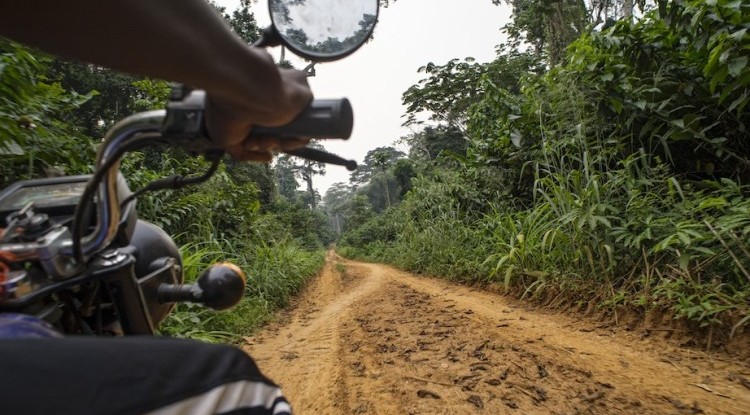
Roads such as this are arteries to the forest, allowing people to access fruits, plants and bushmeat. Ollivier Girard/CIFOR
The Lukolela Police Commander’s rusting Kalashnikov is digging into my thigh as we lunge into the forest on his equally ancient motorbike.
Behind me, a bunch of bananas and a brace of still-alive chickens hang off the back of the bike, flapping and squawking with every rough patch in the dusty red track.
I grit my teeth – already pretty gritty from the dust – and hold on.
Lukolela is a town of wide, bicycle-plied streets and mud-and-wood houses, 540 kilometres up the Congo River from the capital city Kinshasa in the Democratic Republic of Congo.
It is accessible only by river, in a journey that can take anywhere from 2 days to two weeks from the capital.
We’ve made the trip to see firsthand what CIFOR scientists are working on in the area, and to learn more about how deforestation is affecting communities.
And now, we’re about to head 60 kilometres out of town to somewhere even more remote – a forest reserve preserving a biodiverse segment of the Congo Basin jungle.
Lukolela has a population of just 30,000 people. But even a settlement this small has a noticeable impact on the environment.
The circle of deforestation around the town is 20 kilometres thick. All the way in to the reserve we pass village after village, family after family, relying heavily on the forest for food, shelter and income.
Children shriek and jump up and down waving as we pass – shouting ‘mbote’ at me – ‘hello’ in one of the DRC’s national languages, Lingala – and once, near the headquarters of a Chinese logging company, “c’est les Chinois!” (it’s the Chinese!)
They are adorable – all big eyes, big smiles, round tummies, and antenna hairstyles – but the sheer numbers of kids clustering on the side of the road in every village are evidence of a population problem that is increasing pressure on limited forest resources.
People are travelling further and further to find firewood, fruits, building materials and bushmeat.
We pass women with baskets half their height strapped to their backs and laden with firewood; children with huge bunches of bananas or bundles of leaves; and men lugging jerry-cans of home-brewed cassava rum on decrepit bicycles.
This will be my enduring image of the Congo – an unending stream of people bringing forth the fruits of the forest along every road and dirt track, every day, to every village in this vast green basin.

The communications team travelled by motorbike to the Tumba-Lediima Reserve, accompanied by local government officials, police, and some chickens. Babatope Akinwande.
The rainforest is a major source of life and livelihood for people here; and to study the forest is to study the ways it is entwined with the lives of its inhabitants – something much of CIFOR’s work in the region touches on.
Our five motorcycles pull up at the Tumba-Lediima Forest Reserve. The commander and I are the last to arrive – and as he swings off the bike, the reserve’s two dozen forest guards salute, step to attention and welcome him with military precision.
It’s no charade – the guards have been given army training to help them defend themselves against attacks by villagers, furious at the reserve’s restrictions on hunting.
We film interviews, take photos, and share a lunch of plantains and beans with the reserve’s Director of Conservation and the commander. But our minders are keen to get back before dark – wisely, as it turns out, as a flat tyre on the way delays us another hour.
Half an hour from Lukolela the sun disappears beyond the Congo River and the light quickly fades. Unfortunately the commander’s motorcycle is not in possession of a functioning headlamp.
One of the other bikes rides close behind to light our way – and so our shadow looms ahead on the track, a many-limbed black beast that capers and gallops as we bounce along. The engines roar – but the insects roar louder.
Images leap out of the darkness – a flash of bright cloth and a woman’s silhouette, a firefly dancing up ahead, a fountain of sparks exploding twenty metres from the top of a burning tree.
And then we round the Catholic church – by far the sturdiest building in town – and are home, at the Catholic mission, our temporary base camp.
Our faces are stained orange and brown with dust, like the aftermath of a fake-tan accident, with a reverse panda effect where our sunglasses have been.
Washing can wait – we still have one more interview to do, with the local doctor, who doesn’t seem to mind that we are orange, and very late – before we get to work downloading video footage, editing photos, and translating interviews. At last, a bath in a bucket of river water – and we fall asleep to the generator’s purr.
For more stories from the Congo Basin, click here.
We want you to share Forests News content, which is licensed under Creative Commons Attribution-NonCommercial-ShareAlike 4.0 International (CC BY-NC-SA 4.0). This means you are free to redistribute our material for non-commercial purposes. All we ask is that you give Forests News appropriate credit and link to the original Forests News content, indicate if changes were made, and distribute your contributions under the same Creative Commons license. You must notify Forests News if you repost, reprint or reuse our materials by contacting forestsnews@cifor-icraf.org.
